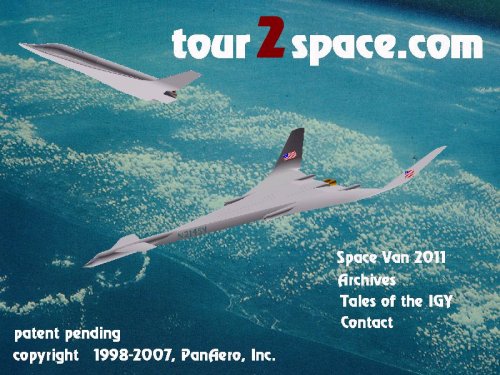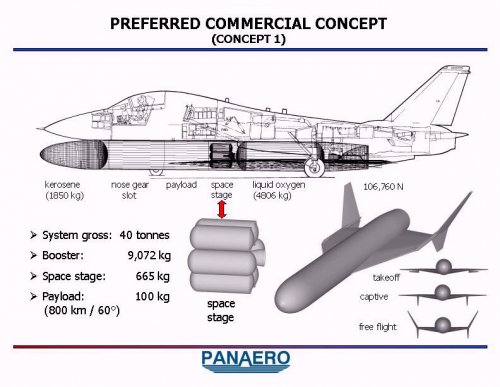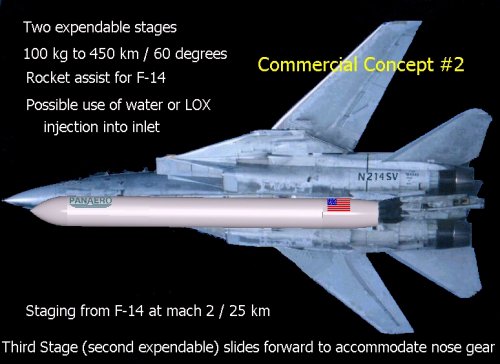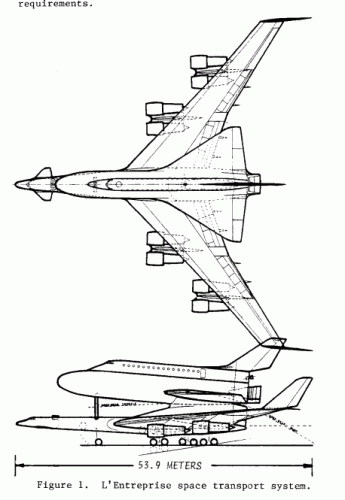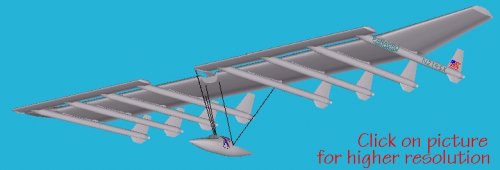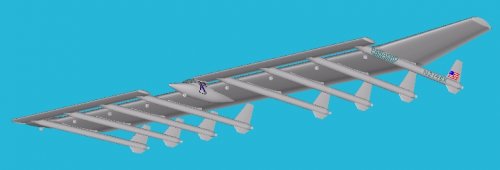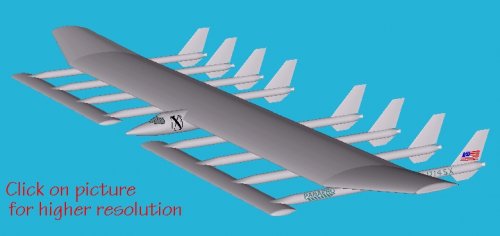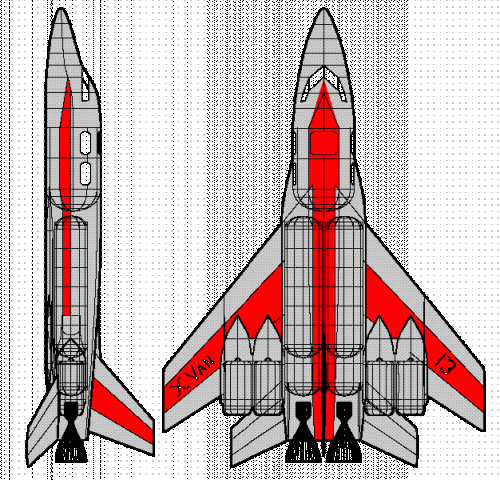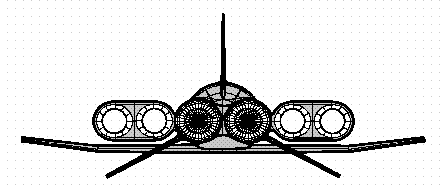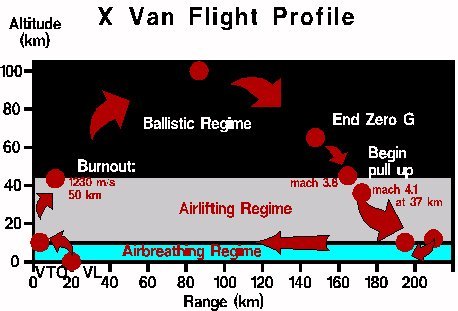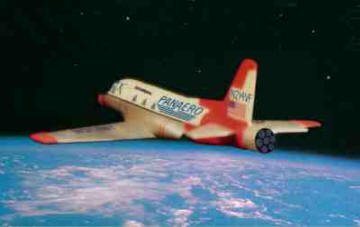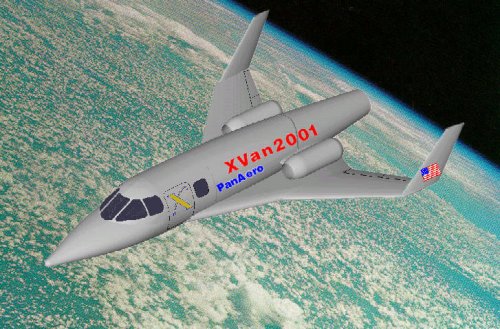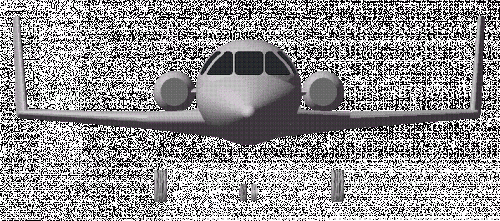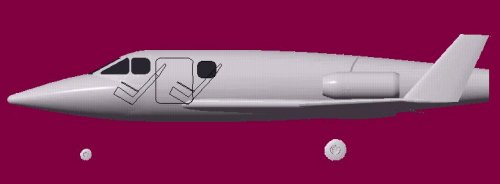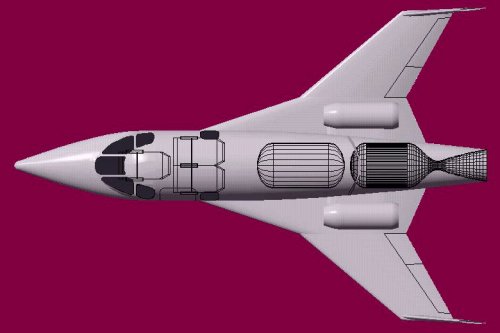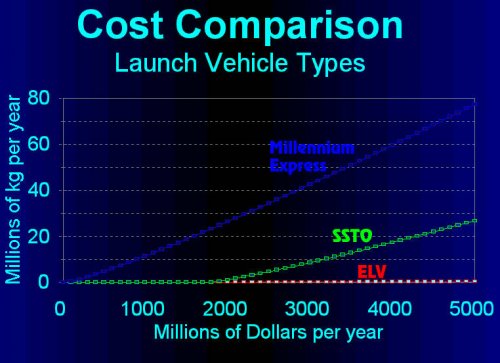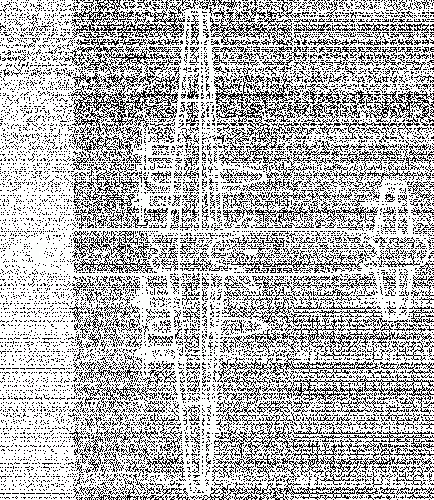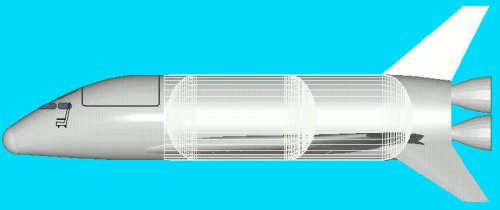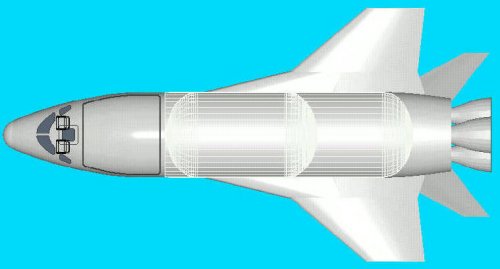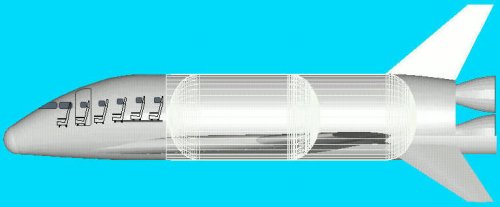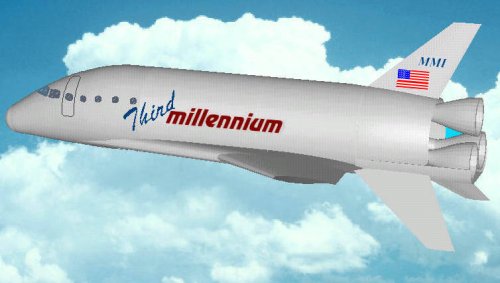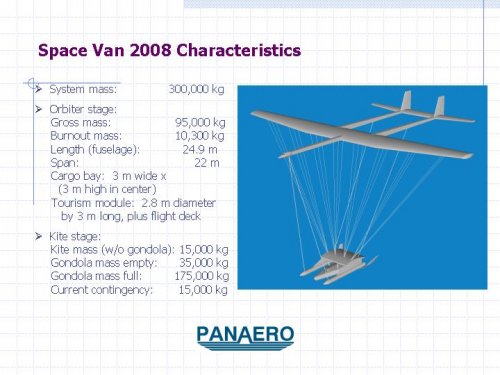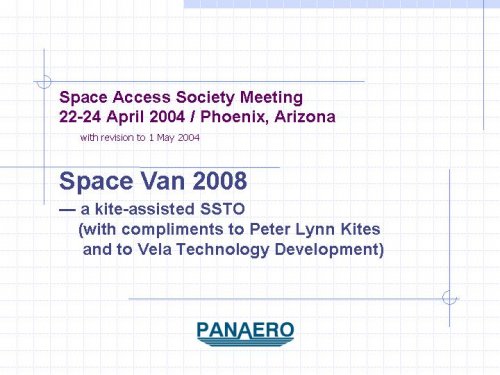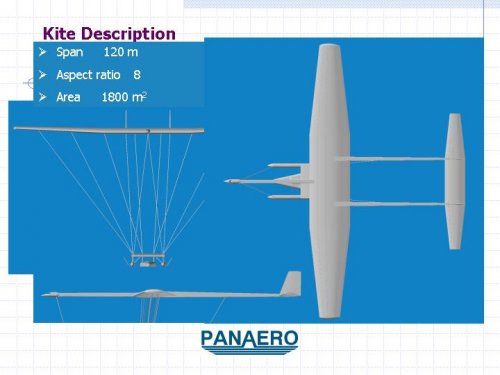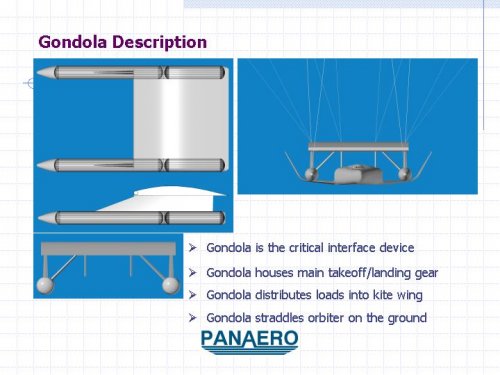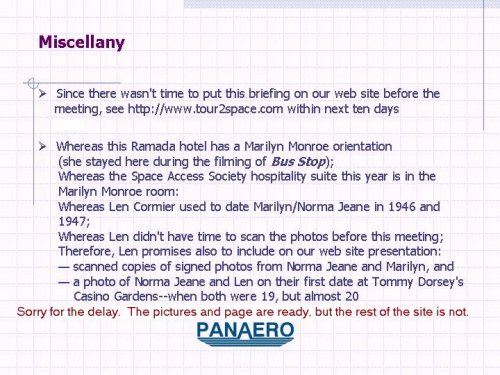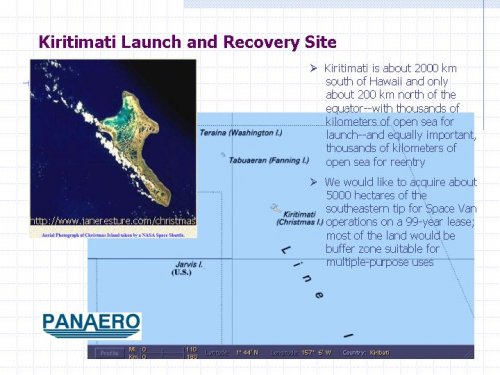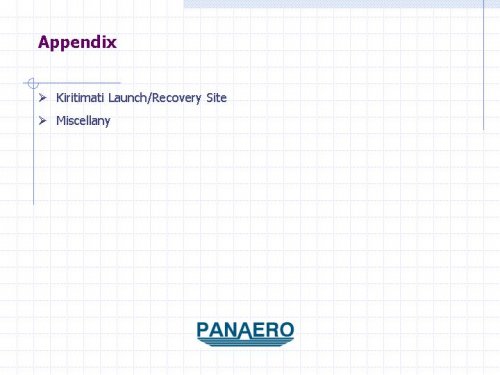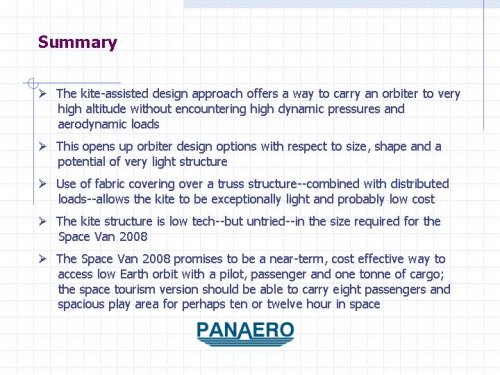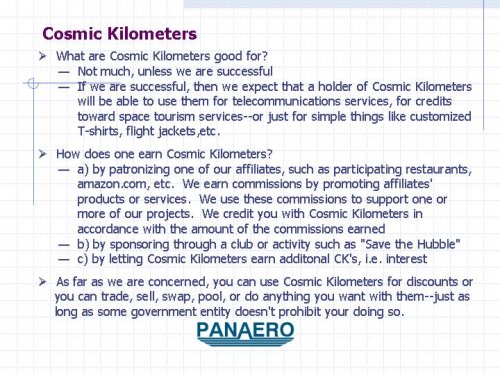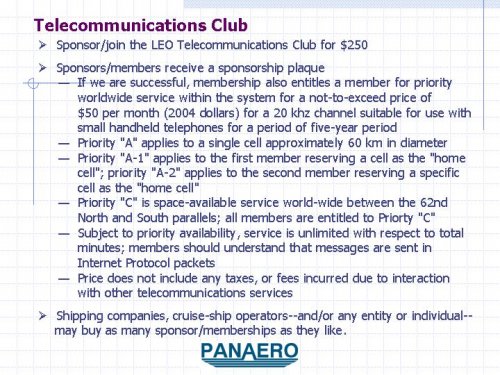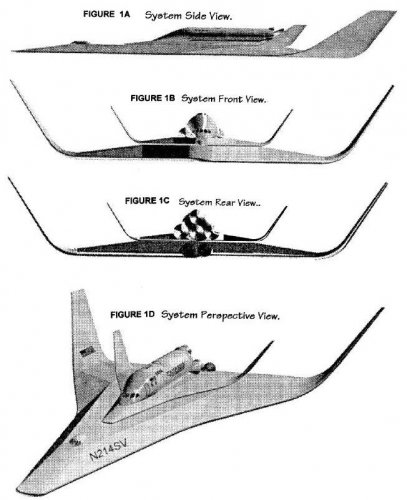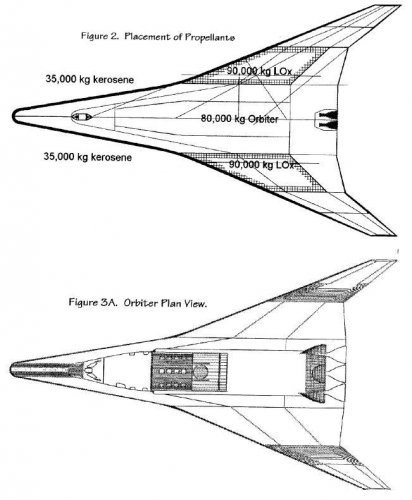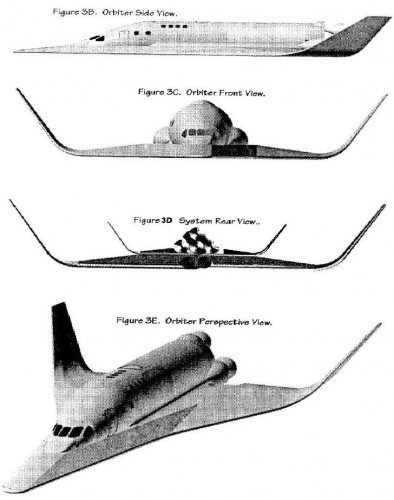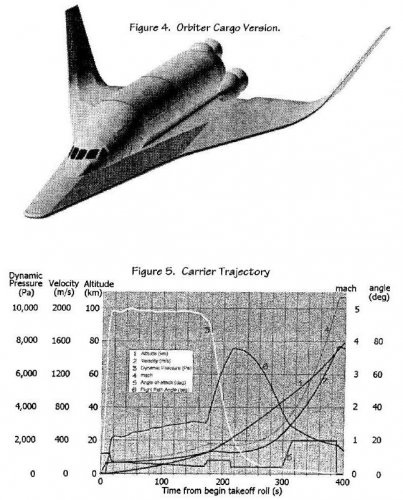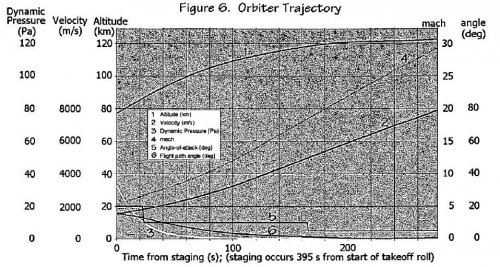You are using an out of date browser. It may not display this or other websites correctly.
You should upgrade or use an alternative browser.
You should upgrade or use an alternative browser.
The Tour2 space
- Thread starter hesham
- Start date
Just call me Ray
ACCESS: Top Secret
- Joined
- 26 August 2007
- Messages
- 672
- Reaction score
- 44
They are indeed nuts.
One of their original X-Prize entrants was nothing more but a sled with a bunch of rocket tubing. Unfortunately information on that concept is no longer available because they probably realized its a bad idea to embarrass yourselves too much.
And they're based right here in Denver :
One of their original X-Prize entrants was nothing more but a sled with a bunch of rocket tubing. Unfortunately information on that concept is no longer available because they probably realized its a bad idea to embarrass yourselves too much.
And they're based right here in Denver :
martinbayer
ACCESS: Top Secret
- Joined
- 6 January 2009
- Messages
- 2,596
- Reaction score
- 2,426
It should be noted that Len Cormier, who originated this design, passed away last year: http://en.wikipedia.org/wiki/Len_Cormier
Apart from this and other concepts listed on the Wikipedia site, he also proposed an air launched orbiter with SSME propulsion that was intended to be lifted by a canard configuration carrier airplane with eight JT9D-70B engines and B-747 wings and landing gear. This concept was published under his name in 1979 in an AIAA paper (Utility of high bypass turbofans for a two-stage space transport, AIAA-1979-879). Intriguingly, the orbiter launch mass, performance and staging conditions are identical respectively extremely close to the values of the Interim Hotol design that was studied 11 years later for launch from an An-225.
Martin
Apart from this and other concepts listed on the Wikipedia site, he also proposed an air launched orbiter with SSME propulsion that was intended to be lifted by a canard configuration carrier airplane with eight JT9D-70B engines and B-747 wings and landing gear. This concept was published under his name in 1979 in an AIAA paper (Utility of high bypass turbofans for a two-stage space transport, AIAA-1979-879). Intriguingly, the orbiter launch mass, performance and staging conditions are identical respectively extremely close to the values of the Interim Hotol design that was studied 11 years later for launch from an An-225.
Martin
- Joined
- 27 May 2007
- Messages
- 676
- Reaction score
- 36
He also proposed a rocket under a Tu-160 Blackjack.
I think I remember him saying said his latest concepts were significantly better than the previous, just a few years before his death, but I don't know if they were ever published.
I think I remember him saying said his latest concepts were significantly better than the previous, just a few years before his death, but I don't know if they were ever published.
XP67_Moonbat
ACCESS: Top Secret
- Joined
- 16 January 2008
- Messages
- 2,252
- Reaction score
- 402
I won't hate on 'em because of their designs. I'm an amateur designer myself. I have a few designs I drew up myself. But until we see actual flown hardware, all those designs will stay designs.
Especially in these hard times. I just don't see it happening. That said, I think they might be certifiable. I still like the designs however.
If they're still in business in another three years, I wonder if they'll have need for a rookie CAD drafter. I could get used to beiing paid for drawing unbuilt spacecraft all day long.
Especially in these hard times. I just don't see it happening. That said, I think they might be certifiable. I still like the designs however.
If they're still in business in another three years, I wonder if they'll have need for a rookie CAD drafter. I could get used to beiing paid for drawing unbuilt spacecraft all day long.
martinbayer
ACCESS: Top Secret
- Joined
- 6 January 2009
- Messages
- 2,596
- Reaction score
- 2,426
Since the founder, head and apparent driving force of the company died last year, and they are evidently an extremely small (if not one man) outfit, it's somewhat unlikely they will still be in business in another three years.
Still, after doing a comparative analysis of the L'Entreprise concept with Interim Hotol and its carrier aircraft as well as other Soviet/Russian RLV designs associated with that aircraft back in the Nineties, even at that time I got the impression that his 1979 AIAA paper was in fact at least one of the inspirations respectively motivations for designing and building the An-225...
Martin
Still, after doing a comparative analysis of the L'Entreprise concept with Interim Hotol and its carrier aircraft as well as other Soviet/Russian RLV designs associated with that aircraft back in the Nineties, even at that time I got the impression that his 1979 AIAA paper was in fact at least one of the inspirations respectively motivations for designing and building the An-225...
Martin
martinbayer said:Apart from this and other concepts listed on the Wikipedia site, he also proposed an air launched orbiter with SSME propulsion that was intended to be lifted by a canard configuration carrier airplane with eight JT9D-70B engines and B-747 wings and landing gear. This concept was published under his name in 1979 in an AIAA paper (Utility of high bypass turbofans for a two-stage space transport, AIAA-1979-879).
Shazam.
Attachments
FutureSpaceTourist
ACCESS: Top Secret
- Joined
- 10 March 2010
- Messages
- 589
- Reaction score
- 26
Just call me Ray said:One of their original X-Prize entrants was nothing more but a sled with a bunch of rocket tubing.
Not sure, but I think you mean the Condor-X? On a positive note it's an original design ...
This is the description from the now defunct tour2space website:
[quote author=tour2space website]
Reaching an altitude of 100 km is a big challenge for an X PRIZE team. But getting down safely from that altitude is the really hard part. Most of the X PRIZE concepts are at either zero speed--or very low speed--at an apogee of about 100 km. This generally means that the vehicle will accelerate to supersonic speeds before the air is dense enough to provide much aerodynamic drag or lift. Unlike reentry from orbit at a grazing angle to the atmosphere, the X PRIZE vehicle is likely to be traveling vertically--thereby encountering rapid increases in air density. We refer to the product of the density and the square of the speed--divided by two--as the "dynamic pressure." Above mach 1, the air compresses, but "incompressible dyanamic pressure" is still a useful index of the intensity of aerodynamic effects. Return from orbit has its own problems such as very high aerodynamic heating. However, reentry at vertical or steep angles results in very rapid increases in dynamic pressure. This, in turn, can cause very high decelerations and other problems.
PanAero's design approach to this problem calls for a very large wing that we use as sort of parachute to begin deceleration at an unusually high altitude. This prevents speed from building up as high as it might otherwise do. This not only reduces peak reentry speed, but also greatly reduces "g" forces and heating. The Condor X ride to 100 km and back is relatively gentle. Peak acceleration on the way up is less than 3 g's. Peak acceleration on reentry is only 2.8 g's. We hold our speed down to 200 knots indicated air speed initially, since our wing is a fabric-covered aluminum truss. We are still flying with lift greater than thrust--and speed under mach 0.6--until we reach an altitude of nearly 36 km (118,000 ft). This is near the unofficial altitude record set by the NF-104 in 1963 for an aircraft taking off from the ground--or the official record set in 1973 by a MiG-25. Above this altitude, we begin a vertical climb and acceleration to about mach 2.5 at 70 km. We reach a speed of about mach 2.5 at 70 km during reentry.
Climbing at slow speed on rocket power is inefficient, but necessary for our very light weight, very large, fabric-covered wing. Accordingly, we need an unusually high mass ratio to accomplish the mission. Gross mass is 24 tonnes with burnout at about 4400 kg. In order to keep bending moments and shear loads from building up for 300 m^2, 50-meter span wing, we place our eight rocket modules along the span of the wing at 4.5 m intervals. A ground dolly picks up the distributed loads while on the runway. The runway at Wallops island is 200 ft long by 8500 ft long and is well suited for Condor-X takeoffs and landings. Touchdown speed is only about 35 knots.
There has been considerable confusion with respect to whether X PRIZE vehicles should be regulated as launch vehicles or experimental aircraft--or both. In October 2003, the FAA published a ruling that vehicles that had lift greater than thrust for the majority of powered flight (for a given stage) would be treated as experimental aircraft with no requirement for a launch license. Launch licenses are generally more cumbersome than obtaining an airworthiness certificate. Perhaps even more significant is the requirement for an environmental impact statement as part of the launch licensing procedure. PanAero's Condor X may be unique among the X PRIZE entries with resepect to being treated as an experimental aircraft--even for flights qualifying for the X PRIZE.
In order to stabilize the Condor X during reentry when the wing is used basically as a parachute, we envisage lowering the cabin and moving it aft. We intend to hold this attitude until we reach an altitude of about 6000 meters. At this time we raise the cabin by the three forward cables and lock the cabin into the flight configuation. We also pull the aft shroud-line/cables into appropriate slots. The Condor X then enters a steep dive to flying speed and pullout to an appropriate gliding attitude and flight back to the departure runway.
[/quote]
The caption for the second picture below is: "The figure below depicts the Condor X in the landing configuration. The aircraft lands on steerable nose wheels and skid/ventral fins. Touchdown speed is only about 35 knots."
Attachments
FutureSpaceTourist
ACCESS: Top Secret
- Joined
- 10 March 2010
- Messages
- 589
- Reaction score
- 26
Here's another PanAero X-prize concept: X Van.
[quote author=tour2space website]
The X Van is a VTOL aircraft that uses four Rybinsk RD-38 airbreathing lift engines for liftoff, for initial acceleration and climb to altitude, and for vertical hover and recovery. Reusable pressure-fed propulsion modules are used for acceleration and climb sufficient to reach 100 km. Acceleration during boost is held to 3 g's or less. Acceleration during reentry and recovery is held to 4 g's or less.
The current design for the X Van has a mass of 12.6 tonnes at liftoff. Length is 12 meters, and wing span is 8.66 meters. Since the X Van is a VTOL aircraft, it can operate from remote sites or small, stable, ship platforms. For normal operations, only the airbreathing turbojets are used during the subsonic climb to altitude, and for recovery phases -- with a capability for engine-out emergency operation.
PanAero has obtained a permit for permanent import into the United States of the Rybinsk RD-38 lift engines. PanAero is currently negotiating with Rybinskie Motory joint stock company in Rybinsk, Russia for use of their RD-38 engines for the X Van, the Bantam Van and other applications. These engines are operational in the Yak-38 VTOL fighter. They are used for the vertical takeoff and landing phases and have a lift -to-weight ratio of 14 to 1.
PanAero plans to join with a coordinated group comprising PanAero and three other American companies for the development of the pressure-fed rocket propulsion modules. Details of these rocket propulsion modules are proprietary.
PanAero hopes to obtain U.S. government permission to work with the Yak Aircraft Corporation (Yakovlev Design Bureau) in Moscow with respect to design and fabrication of the airframe and airbreathing propulsion system for the X Van. If PanAero receives approval for its proposed Technical Assistance Agreement with the Yak Aircraft Corporation, then the basic airframe -- but not the rocket propulsion modules -- would be built in Russia and the primary airframe material will likely be titanium.
The rocket propellant tanks to be built in the U.S., however, would probably be made by winding graphite filaments around aluminum tanks. The airframe would accommodate the form and fit -- but not function -- of the rocket propulsion modules. PanAero has alternate plans to design and to fabricate the airframe and to integrate the airbreathing propulsion system into the airframe in the United States, should permission not be granted to work with the Yak Aircraft Corporation.
The X Van lifts off vertically using thrust from four RD-38 engines -- plus 20 seconds of thrust from small rocket takeoff assist/abort engines. Should one of the RD-38 engines fail, the engines on the other side are throttled proportionately, and the abort rockets are continued for mission abort. For normal takeoff, the rocket assist/abort engines are shut off about 20 seconds after liftoff.
There is sufficient thrust to launch from an inclined rail as an alternative to vertical liftoff.
The wings help the X Van to reach about 10 km prior to starting the main rocket engines on a normal flight. After starting the main rocket engines, the X Van pulls up to about a 50 degree flight path angle, the RD-38's are shut down, and the inlet doors are closed. The X Van then continues to accelerate and to climb at about a 50 degree flight path angle. After burnout, kinetic energy carries the X Van to an apogee of just over 100 km. The X Van wing enables the X Van to pull out at about 4 g's using only aerodynamic lift and deceleration.
After deceleration to subsonic speed and an altitude of about 10 km, the inlet doors are opened, and the RD-38's are restarted and are kept running at reduced power levels during the gliding descent back to the launch site. At the launch site the wings are used to effect a pullup to a vertical position at low altitude -- with the RD-38's being powered up to maintain altitude and position. Should one of the RD-38's fail at this point, there is sufficient remaining thrust at landing weight to throttle the engines on the opposite side and to maintain hover in the airbreathing-only mode.
Initially, PanAero had planned to integrate fins and horizontal stabilizers with the vertical landing gear. However, tipover considerations made this landing gear much too large. Moreover, pilot disorientation during the "Pogo" vertical landing test years ago suggest a need for pivoting the cabin area 90 degrees for hover and landing. Accordingly, PanAero decided that the X-13 approach of hooking onto some type of crane or gantry device would be much simpler and lighter. The hook would be extended from a compartment just in front of the pilot in order to minimize pilot disorientation during recovery.
The tradeoff between landing gear designed for horizontal landing and the lighter hook device plus additional fuel for hover appears to rather even. However, the current plan for vertical recovery allows the X Van to operate from a small island or a stable sea platform.
The X Van -- with some modification -- is designed to serve as a fully reusable booster module for the orbital version of the X Van (formerly Bantam Van). The orbital version of the X Van will be capable of boosting a fully reusable orbiter to about mach 4 at about 45 km. The fully reusable orbiter is designed around a single RL10A-4-1.
[/quote]
[quote author=tour2space website]
The X Van is a VTOL aircraft that uses four Rybinsk RD-38 airbreathing lift engines for liftoff, for initial acceleration and climb to altitude, and for vertical hover and recovery. Reusable pressure-fed propulsion modules are used for acceleration and climb sufficient to reach 100 km. Acceleration during boost is held to 3 g's or less. Acceleration during reentry and recovery is held to 4 g's or less.
The current design for the X Van has a mass of 12.6 tonnes at liftoff. Length is 12 meters, and wing span is 8.66 meters. Since the X Van is a VTOL aircraft, it can operate from remote sites or small, stable, ship platforms. For normal operations, only the airbreathing turbojets are used during the subsonic climb to altitude, and for recovery phases -- with a capability for engine-out emergency operation.
PanAero has obtained a permit for permanent import into the United States of the Rybinsk RD-38 lift engines. PanAero is currently negotiating with Rybinskie Motory joint stock company in Rybinsk, Russia for use of their RD-38 engines for the X Van, the Bantam Van and other applications. These engines are operational in the Yak-38 VTOL fighter. They are used for the vertical takeoff and landing phases and have a lift -to-weight ratio of 14 to 1.
PanAero plans to join with a coordinated group comprising PanAero and three other American companies for the development of the pressure-fed rocket propulsion modules. Details of these rocket propulsion modules are proprietary.
PanAero hopes to obtain U.S. government permission to work with the Yak Aircraft Corporation (Yakovlev Design Bureau) in Moscow with respect to design and fabrication of the airframe and airbreathing propulsion system for the X Van. If PanAero receives approval for its proposed Technical Assistance Agreement with the Yak Aircraft Corporation, then the basic airframe -- but not the rocket propulsion modules -- would be built in Russia and the primary airframe material will likely be titanium.
The rocket propellant tanks to be built in the U.S., however, would probably be made by winding graphite filaments around aluminum tanks. The airframe would accommodate the form and fit -- but not function -- of the rocket propulsion modules. PanAero has alternate plans to design and to fabricate the airframe and to integrate the airbreathing propulsion system into the airframe in the United States, should permission not be granted to work with the Yak Aircraft Corporation.
The X Van lifts off vertically using thrust from four RD-38 engines -- plus 20 seconds of thrust from small rocket takeoff assist/abort engines. Should one of the RD-38 engines fail, the engines on the other side are throttled proportionately, and the abort rockets are continued for mission abort. For normal takeoff, the rocket assist/abort engines are shut off about 20 seconds after liftoff.
There is sufficient thrust to launch from an inclined rail as an alternative to vertical liftoff.
The wings help the X Van to reach about 10 km prior to starting the main rocket engines on a normal flight. After starting the main rocket engines, the X Van pulls up to about a 50 degree flight path angle, the RD-38's are shut down, and the inlet doors are closed. The X Van then continues to accelerate and to climb at about a 50 degree flight path angle. After burnout, kinetic energy carries the X Van to an apogee of just over 100 km. The X Van wing enables the X Van to pull out at about 4 g's using only aerodynamic lift and deceleration.
After deceleration to subsonic speed and an altitude of about 10 km, the inlet doors are opened, and the RD-38's are restarted and are kept running at reduced power levels during the gliding descent back to the launch site. At the launch site the wings are used to effect a pullup to a vertical position at low altitude -- with the RD-38's being powered up to maintain altitude and position. Should one of the RD-38's fail at this point, there is sufficient remaining thrust at landing weight to throttle the engines on the opposite side and to maintain hover in the airbreathing-only mode.
Initially, PanAero had planned to integrate fins and horizontal stabilizers with the vertical landing gear. However, tipover considerations made this landing gear much too large. Moreover, pilot disorientation during the "Pogo" vertical landing test years ago suggest a need for pivoting the cabin area 90 degrees for hover and landing. Accordingly, PanAero decided that the X-13 approach of hooking onto some type of crane or gantry device would be much simpler and lighter. The hook would be extended from a compartment just in front of the pilot in order to minimize pilot disorientation during recovery.
The tradeoff between landing gear designed for horizontal landing and the lighter hook device plus additional fuel for hover appears to rather even. However, the current plan for vertical recovery allows the X Van to operate from a small island or a stable sea platform.
The X Van -- with some modification -- is designed to serve as a fully reusable booster module for the orbital version of the X Van (formerly Bantam Van). The orbital version of the X Van will be capable of boosting a fully reusable orbiter to about mach 4 at about 45 km. The fully reusable orbiter is designed around a single RL10A-4-1.
[/quote]
Attachments
FutureSpaceTourist
ACCESS: Top Secret
- Joined
- 10 March 2010
- Messages
- 589
- Reaction score
- 26
Just to prove that you can't have too much of a good thing ... here's a third (and I believe only other?) PanAero X-prize concept. Actually it was their 'official' X-prize concept, as it's the one that appears on the X-prize site (http://space.xprize.org/ansari-x-prize).
This concept is rather more conventional, ie addition of (7!) rockets to an existing airframe (like the Pioneer Rocketplane X-prize entry based on a LearJet). In PanAero's case the aircraft is a Sabre-40 jet, the resulting spaceplane being SabreRocket.
I haven't been able to find much information about it, other than the details in the attached PDF dated 2002 (from the X-prize site).
This concept is rather more conventional, ie addition of (7!) rockets to an existing airframe (like the Pioneer Rocketplane X-prize entry based on a LearJet). In PanAero's case the aircraft is a Sabre-40 jet, the resulting spaceplane being SabreRocket.
I haven't been able to find much information about it, other than the details in the attached PDF dated 2002 (from the X-prize site).
Attachments
If they're still in business in another three years, I wonder if they'll have need for a rookie CAD drafter. I could get used to beiing paid for drawing unbuilt spacecraft all day long. Wink
Yeah...I've been trying that. No success yet...book project notwithstanding.
FutureSpaceTourist
ACCESS: Top Secret
- Joined
- 10 March 2010
- Messages
- 589
- Reaction score
- 26
FutureSpaceTourist said:Here's another PanAero X-prize concept: X Van.
So turns out this was only the first X Van X-prize concept! It was followed by X Van 2001:
[quote author=tour2Space website]
"The XVan2001 taxis, takesoff from a runway, and climbs to mach 0.8 and 11 km using only its surplus J-85 jet engines. The rocket engine would be started at 11 km altitude for acceleration to mach 3.7 at about 50 km at a 60 degree flight path angle. The XVan2001 then would coast up to slightly above 100 km -- reentering the atmosphere at mach 3.8 at 40 km. During reentry, the pilot seat and two pasenger seats are reclined as shown to avoid an "eyballs-out" situation from rapid deceleration. After pulling out of the steep dive at 4.5 g's, the XVan2001 would accelerate to subsonic speed. The J-85s would then be restarted for flyback and a powered approach to the same runway from which the XVan2001 took off.
"The XVan2001 is quite small and light. Initial flight tests without rocket propellants will be at a takeoff gross mass of only 1800 kg and will use only the retractable landing gear. However, rocket flights will use a special truck capable of supporting a gross mass of 3600 while traveling 110 knots on the runway. Landing is always on the retractable landing gear. Wing span is only 7 meters; length is 10.4 meters.
We are currently considering several candidates for the rocket engine, including the hybrid approach shown in the above drawings.
PanAero has designed the XVan2001 to be simple, cheap, and fast to build -- we expect to build it for just 1 percent the cost of our proposed, orbit-capable Millennium Express. Our earlier, suborbital X PRIZE concept would also have have been much more expensive to build -- even with permission from the U.S. State Department to work with the Yakovlev Design Bureau (which permission was never given nor denied). Part of our lower cash requirements is due to: 1) proprietary structural and other concepts; and 2) new team members and the recent availability of a new, low-cost facility. Accordingly, our cash input requirements have been reduced to about $2,000,000. Therefore, we may be able to build the XVan2001 with the sponsorship of folks like you. We are inviting potential sponsors to join us in this effort now. We would really appreciate your sponsorship. We think the technical part is relatively easy; raising the money necessary for a good try is what is hard.
If there is sufficient sponsorship interest, we will focus on the XVan2001 for the near future. The XVan2001 should complement the orbit-capable Millennium Express. We can build the XVan2001 much quicker and cheaper than the Millennium Express. Thus, the XVan2001 would be a much more timely candidate for the X PRIZE. Once built, we would hope to use the XVan2001 as a trainer and a component develpment test-bed for the orbit-capable Millennium Express -- which, of course, has a far larger business potential for revolutionizing space-based telecommunications and other commercial space missions.
If there is insufficient sponsorship interest in the XVan2001, we shall continue with our current plan to focus on the orbit-capable Millennium Express -- with the idea that if it becomes available soon enough to win the X PRIZE, then that will be an important bonus.
Note: PanAero, Inc. -- an affiliate of Third Millennium Aerospace, Inc. and Space Tour -- is one of sixteen teams entered into the X PRIZE competition. Our earlier concept for the X PRIZE was designed to include the Yakovlev Design Bureau as a team member for building the airframe. The earlier concept was based upon the the high-thrust-to weight Rybinsk RD-38 turbojet engine that is operational in the Yakovlev Yak-38 VTOL fighter -- together with a pressure-fed rocket system that would have been installed after the airframe was delivered to the United States. However, our request to the U.S. State Department remains unresolved after more than three years. Accordingly, we have abandoned our earlier concept and adopted a new strategy for the X PRIZE contest. The XVan2001 concept is significantly smaller and simpler than our earlier concept.
We have changed our nomenclature somewhat for two reasons:
a) Our two-stage-to-orbit (TSTO) vehicle has so many new improvements that we have redesignated it as the "Millennium Express." (The old name was the X Van for both the booster and the orbiter, as well as the two stage system). Like the earlier TSTO concept, either the booster or the orbiter of the Millennium Express would qualify for the X PRIZE, if it were ready on time.
b) We have recently come up with a minimum-size, minimum-cost candidate for the X PRIZE itself. We call this new vehicle the XVan2001.
[/quote]
Hope that's all clear now ... ???
Attachments
FutureSpaceTourist
ACCESS: Top Secret
- Joined
- 10 March 2010
- Messages
- 589
- Reaction score
- 26
Here are details of the Millennium Express TSTO refered to above. It uses a modified AN-22 as a carrier plane.
Details are split into two posts due to the number of pictures. This first part just covers the intro/economics.
[quote author=tour2space website]
The chart [below] compares launch-cost estimates for various types of launch vehicles. On the scale depicted on the Y-axis -- millions of kg per year -- expendable launch vehicles (ELVs) barely show. The world currently spends more than $5 billion per year on current ELVs. However, this only pays for launching about 350,000 kg of payload per year, or about a third of million kg per year. The currently proposed single-stage-to-orbit (SSTO) reusable launch vehicle (RLV) would improve launch economics greatly, if the market for such a vehicle would appear overnight. However, an SSTO may take a $6 billion investment before it could become operational. If this were a private investment spread over a four-year period and if expected return on investment (ROI) were perhaps 26 percent per year (three-year doubling time), then revenue operations would have to produce about $1.8 billion per year. This would be before any money is spent for recurring operational costs. SSTO recurring operational costs might only be about $5 million per flight. And these would drop even more at higher traffic levels in accordance with a "learning curve." However, at traffic levels of perhaps 25 flights per year, the ROI part of the price would have to be about $72 million per flight. The main problem is that it will take time to transition from an ELV-based market measured in terms of hundreds of tonnes per year of high-cost payloads to an RLV-based market measured in terms of tens of thousands of tonnes per year of low-cost payloads. The SSTO is not economically attractive during this transition period.
Our Millennium Express two-stage-to-orbit (TSTO) RLV addresses this transition problem by minimizing pre-operational investment. We hope to hold investment to about $170 million (2001 dollars). We assume $200 million for purposes of the above chart. We also expect to hold per flight recurring operational costs to about $240,000 to $300,000 per flight, since our orbiter is quite small and does not rely on any exotic technology. In fact, the orbiter is powered by rocket engines that have been mothballed for 25 years. Our preferred subsonic carrier stage is a modification of an aircraft that has been flying for 36 years -- powered by engines that have been flying for 46 years. With the economics promised by the Millennium Express, we expect to make economic sense with a relatively small amount of initial revenue, i.e. as little as $100 or $200 million per year. This enables consideration of a vertical integration strategy. Thus, our initial business is likely to be telecommunications. However, we also expect to be able to offer attractively prices space tourism services -- once the regulatory hurdles become manageable.
Our payload is also much smaller than the payload for the SSTO, of course. However, our recurring cost per kg of payload to low Earth orbit (LEO) promises to be only about 40 percent that for the SSTO. The SSTO is attractive to potential customers desiring large payloads. An SSTO is also operationally attractive. However, we believe our approach to a TSTO/RLV also provides for relatively simple operations. Once the transition is made to an RLV-based market, there should be room for a variety of RLVs. We believe that our Millennium Express is the key to making the transition happen.
[/quote]
Details are split into two posts due to the number of pictures. This first part just covers the intro/economics.
[quote author=tour2space website]
The chart [below] compares launch-cost estimates for various types of launch vehicles. On the scale depicted on the Y-axis -- millions of kg per year -- expendable launch vehicles (ELVs) barely show. The world currently spends more than $5 billion per year on current ELVs. However, this only pays for launching about 350,000 kg of payload per year, or about a third of million kg per year. The currently proposed single-stage-to-orbit (SSTO) reusable launch vehicle (RLV) would improve launch economics greatly, if the market for such a vehicle would appear overnight. However, an SSTO may take a $6 billion investment before it could become operational. If this were a private investment spread over a four-year period and if expected return on investment (ROI) were perhaps 26 percent per year (three-year doubling time), then revenue operations would have to produce about $1.8 billion per year. This would be before any money is spent for recurring operational costs. SSTO recurring operational costs might only be about $5 million per flight. And these would drop even more at higher traffic levels in accordance with a "learning curve." However, at traffic levels of perhaps 25 flights per year, the ROI part of the price would have to be about $72 million per flight. The main problem is that it will take time to transition from an ELV-based market measured in terms of hundreds of tonnes per year of high-cost payloads to an RLV-based market measured in terms of tens of thousands of tonnes per year of low-cost payloads. The SSTO is not economically attractive during this transition period.
Our Millennium Express two-stage-to-orbit (TSTO) RLV addresses this transition problem by minimizing pre-operational investment. We hope to hold investment to about $170 million (2001 dollars). We assume $200 million for purposes of the above chart. We also expect to hold per flight recurring operational costs to about $240,000 to $300,000 per flight, since our orbiter is quite small and does not rely on any exotic technology. In fact, the orbiter is powered by rocket engines that have been mothballed for 25 years. Our preferred subsonic carrier stage is a modification of an aircraft that has been flying for 36 years -- powered by engines that have been flying for 46 years. With the economics promised by the Millennium Express, we expect to make economic sense with a relatively small amount of initial revenue, i.e. as little as $100 or $200 million per year. This enables consideration of a vertical integration strategy. Thus, our initial business is likely to be telecommunications. However, we also expect to be able to offer attractively prices space tourism services -- once the regulatory hurdles become manageable.
Our payload is also much smaller than the payload for the SSTO, of course. However, our recurring cost per kg of payload to low Earth orbit (LEO) promises to be only about 40 percent that for the SSTO. The SSTO is attractive to potential customers desiring large payloads. An SSTO is also operationally attractive. However, we believe our approach to a TSTO/RLV also provides for relatively simple operations. Once the transition is made to an RLV-based market, there should be room for a variety of RLVs. We believe that our Millennium Express is the key to making the transition happen.
[/quote]
Attachments
FutureSpaceTourist
ACCESS: Top Secret
- Joined
- 10 March 2010
- Messages
- 589
- Reaction score
- 26
Second and final posting on Millennium Express.
[quote author=tour2space website]

This rendering depicts the orbiter stage of the Millennium Express as it might look just prior to approach and landing at the original launch site. The Millennium Express is a two-stage-to-orbit reusable launch vehicle (RLV) that stages subsonically at about mach 0.5 and a 15-km altitude and high flight path angle. This launch approach allows us to avoid large aerodynamic forces that would otherwise design the orbiter wing. The preferred concept for the carrier stage uses a large straight wing and large turboprop engines to allow efficient climb while constraining aerodynamic forces on the orbiter wing during the climb to launch altitude. The carrier stage also use rocket assist above about 10-km altitude to reach 15 km and relatively thin air prior to separation of the orbiter from the carrier stage. The orbiter stage follows an essentially ballistic trajectory after separation at a high flight path angle. Thus the orbiter wing is used only for reentry, approach and landing. This is the key design trick for the Millennium Express -- a design trick that we hope to patent. The savings in orbiter wing mass is equivalent to perhaps six times the system payload. Our performance and cost goals are dependent upon good system design and some design tricks -- not on exotic technology. We treat our goal of constraining pre-operational investment to under $200 million as a basic design requirement.
In the rendering above, the ventral fins have been translated forward from their aft reentry position. In their forward position, these ventral fins also serve as landing skids in conjunction with a steerable nose wheel. The X-15 used this arrangement. The aft position of these ventrals is necessary during reentry to avoid severe heating problems associated with ventral intersections with a lower surface. The ventrals are rotated upward for ground clearance prior to takeoff of the carrier stage -- or during landing with the orbiter stage still attached.
The orbiter stage is powered by one Lyulka D-57 LOX / hydrogen and two Kuznetsov NK-39 LOX / kerosene rocket engines. These engines are offered by GenCorp / Aerojet of Sacramento, California in accordance with a long-standing marketing agreement with Russian engine companies. These engines were first manufactured in the mid-1970s, and have been mothballed since that time. Nonetheless, specific impulse of the D-57 is 4472 m/s and thrust is about 370,000 newtons; specific impulse of the NK-39 engines with the fully expanded nozzle is 3452 m/s and thrust is in the 400,000 newton class. See Astronautix.com. Near the end of burn, we shall use only the D-57 engine to limit acceleration and to maximize specific impulse. Aerojet plans to improve the throttling capability of all of these engines-- as they have with the similar, but larger AJ-26 engine they are providing to Kistler Aerospace for the K-1 RLV. However, our three-engine approach does not require much throttling to limit acceleration forces for missions with people on board to 3-gs.
The passenger version carries sixteen passengers -- in addition to the pilot and copilot / flight attendant.
Cargo payload to a 110-km, 60-degree orbit is an estimated 1800 kg. The cargo bay is suitable for a 3.6-meter long by 3-meter diameter satellite. This is our primary orbit for our primary application: a large number of self-propelled communications satellite for deployment to 800-km altitude.
Our secondary orbit is a 450-km, 15-degree orbit for assembly of large geosynchronous satellites. Payload to this orbit is about 2400 kg. Cargo flights also carry a pilot and one copilot / crew member.
Following is a two-view of the passenger version of the orbiter stage.


The flight deck and cabin areas comprise the upper portion of the nose section. The cabin floor ramps upward to make full utilization of the available space. The aft portion of the cabin is elevated sufficiently to allow a small elevator aft and a lower deck with two toilets. The spherical helium tank forms the nose of the vehicle. The nose gear and part of the kerosene is located below the flight deck; the remaining portion of the kerosene is below the forward portion of the cabin. The large liquid hydrogen tank for the low density hydrogen is located just behind the cabin; the liquid oxygen (LOX) tank is aft of the hydrogen tank and forward of the engine compartment. There is very little shift in the center of gravity during rocket burn.
Following is a two-view of the cargo version of the orbiter of the Millennium Express.


The cargo door accommodates cylindrical payloads up to 3 meters in diameter and 3.6 meters in length. A conical shaped payload could be somewhat wider at one end. For structural reasons, the door is a single piece, not a clamshell arrangement as on the Space Shuttle. As with the passenger version, kerosene occupies the lower portion of the nose section that includes the payload bay. However, the cargo deck is much lower than the deck of the passenger cabin, and the kerosene -- plus the nose gear -- occupies the entire lower portion of the nose section. The cargo version deck is indented to accommodate a 3-meter diameter preassembled payload. A special adaptor provides a level deck for other purposes.
Whereas the passenger version is designed to reenter and land with a full payload, the cargo version is designed to reenter and land empty. This necessitates moving the wing aft about 2 meters for proper balance. At gross mass, the cargo version is too stable. However, the orbiter flies a basically ballistic trajectory during exit. Accordingly, the overly stable condition at separation should not be a problem.
Our preferred concept for the carrier stage is modification of the Antonov An-22 Antheus large turboprop transport. This aircraft was developed 36 years ago for transporting military cargo. Aeroflot used a later version as a commercial transport. The An-22 is powered by four Kuznetsov 15,000 HP turboprop engines and counter-rotating propellers. In case you're wondering -- yes, you're right, that's the same Kuznetsov that built the NK-39 rocket engines that we plan to use in the orbiter.
Three major modifications are necessary to make the An-22 suitable for our concept for the carrier stage of the Millennium Express. First, we shall have to move the main gear outboard into pods suspended on pylons. This allows us to carry a winged orbiter near the center of gravity and under the An-22. We then want to cut a cavity in the belly of the An-22 to carry the orbiter in semi-submerged fashion. We shall also have to beef up some of the fuselage structure that is otherwise weakend for the cutout; we shall also have to find or to develop appropriate hardpoints for suspension of the orbiter and for extending the orbiter below the An-22 fuselage prior to separation. The other major modification is to install a rocket assist system for subsonic climb from 10 km to 15 km at perhaps a 30-degree flight path angle. Some of the NK-39 engines already come with truncated nozzles; a pair of these engines may be suitable. At the present time, we also show the orbiter dorsal vertical protruding through a slot in the upper fuselage of the An-22 behind the wing carrythrough. If this proves to be impractical, then we should either make the orbital vertical somewhat stubbier, or we would fold it partly.
The An-22 is very well suited for our purposes. We want simple, straightforward operations. We also want to be able to climb efficiently to altitude at relatively low speed to preclude having the orbiter wing encounter large aerodynamic forces. The Kuznetsov NK-12 turboprop engine is much larger than any other turboprop engine in the world. It is also used on the Tupolov Tu-95 "Bear" bomber and other aircraft. The An-22 has a large straight wing that is appropriate for medium-speed climb to relatively high altitude. The fuselage diameter is nearly half again the diameter of our proposed orbiter -- thereby permitting the semi-submerged approach. The An-22 has a normal gross mass at takeoff of 250 tonnes.
Following is a three view of the modified An-22 with the Millennium Express orbiter attached. Not much of the orbiter shows in these views; a bottom view would show more of the orbiter.



[/quote]
[quote author=tour2space website]
This rendering depicts the orbiter stage of the Millennium Express as it might look just prior to approach and landing at the original launch site. The Millennium Express is a two-stage-to-orbit reusable launch vehicle (RLV) that stages subsonically at about mach 0.5 and a 15-km altitude and high flight path angle. This launch approach allows us to avoid large aerodynamic forces that would otherwise design the orbiter wing. The preferred concept for the carrier stage uses a large straight wing and large turboprop engines to allow efficient climb while constraining aerodynamic forces on the orbiter wing during the climb to launch altitude. The carrier stage also use rocket assist above about 10-km altitude to reach 15 km and relatively thin air prior to separation of the orbiter from the carrier stage. The orbiter stage follows an essentially ballistic trajectory after separation at a high flight path angle. Thus the orbiter wing is used only for reentry, approach and landing. This is the key design trick for the Millennium Express -- a design trick that we hope to patent. The savings in orbiter wing mass is equivalent to perhaps six times the system payload. Our performance and cost goals are dependent upon good system design and some design tricks -- not on exotic technology. We treat our goal of constraining pre-operational investment to under $200 million as a basic design requirement.
In the rendering above, the ventral fins have been translated forward from their aft reentry position. In their forward position, these ventral fins also serve as landing skids in conjunction with a steerable nose wheel. The X-15 used this arrangement. The aft position of these ventrals is necessary during reentry to avoid severe heating problems associated with ventral intersections with a lower surface. The ventrals are rotated upward for ground clearance prior to takeoff of the carrier stage -- or during landing with the orbiter stage still attached.
The orbiter stage is powered by one Lyulka D-57 LOX / hydrogen and two Kuznetsov NK-39 LOX / kerosene rocket engines. These engines are offered by GenCorp / Aerojet of Sacramento, California in accordance with a long-standing marketing agreement with Russian engine companies. These engines were first manufactured in the mid-1970s, and have been mothballed since that time. Nonetheless, specific impulse of the D-57 is 4472 m/s and thrust is about 370,000 newtons; specific impulse of the NK-39 engines with the fully expanded nozzle is 3452 m/s and thrust is in the 400,000 newton class. See Astronautix.com. Near the end of burn, we shall use only the D-57 engine to limit acceleration and to maximize specific impulse. Aerojet plans to improve the throttling capability of all of these engines-- as they have with the similar, but larger AJ-26 engine they are providing to Kistler Aerospace for the K-1 RLV. However, our three-engine approach does not require much throttling to limit acceleration forces for missions with people on board to 3-gs.
The passenger version carries sixteen passengers -- in addition to the pilot and copilot / flight attendant.
Cargo payload to a 110-km, 60-degree orbit is an estimated 1800 kg. The cargo bay is suitable for a 3.6-meter long by 3-meter diameter satellite. This is our primary orbit for our primary application: a large number of self-propelled communications satellite for deployment to 800-km altitude.
Our secondary orbit is a 450-km, 15-degree orbit for assembly of large geosynchronous satellites. Payload to this orbit is about 2400 kg. Cargo flights also carry a pilot and one copilot / crew member.
Following is a two-view of the passenger version of the orbiter stage.
The flight deck and cabin areas comprise the upper portion of the nose section. The cabin floor ramps upward to make full utilization of the available space. The aft portion of the cabin is elevated sufficiently to allow a small elevator aft and a lower deck with two toilets. The spherical helium tank forms the nose of the vehicle. The nose gear and part of the kerosene is located below the flight deck; the remaining portion of the kerosene is below the forward portion of the cabin. The large liquid hydrogen tank for the low density hydrogen is located just behind the cabin; the liquid oxygen (LOX) tank is aft of the hydrogen tank and forward of the engine compartment. There is very little shift in the center of gravity during rocket burn.
Following is a two-view of the cargo version of the orbiter of the Millennium Express.
The cargo door accommodates cylindrical payloads up to 3 meters in diameter and 3.6 meters in length. A conical shaped payload could be somewhat wider at one end. For structural reasons, the door is a single piece, not a clamshell arrangement as on the Space Shuttle. As with the passenger version, kerosene occupies the lower portion of the nose section that includes the payload bay. However, the cargo deck is much lower than the deck of the passenger cabin, and the kerosene -- plus the nose gear -- occupies the entire lower portion of the nose section. The cargo version deck is indented to accommodate a 3-meter diameter preassembled payload. A special adaptor provides a level deck for other purposes.
Whereas the passenger version is designed to reenter and land with a full payload, the cargo version is designed to reenter and land empty. This necessitates moving the wing aft about 2 meters for proper balance. At gross mass, the cargo version is too stable. However, the orbiter flies a basically ballistic trajectory during exit. Accordingly, the overly stable condition at separation should not be a problem.
Our preferred concept for the carrier stage is modification of the Antonov An-22 Antheus large turboprop transport. This aircraft was developed 36 years ago for transporting military cargo. Aeroflot used a later version as a commercial transport. The An-22 is powered by four Kuznetsov 15,000 HP turboprop engines and counter-rotating propellers. In case you're wondering -- yes, you're right, that's the same Kuznetsov that built the NK-39 rocket engines that we plan to use in the orbiter.
Three major modifications are necessary to make the An-22 suitable for our concept for the carrier stage of the Millennium Express. First, we shall have to move the main gear outboard into pods suspended on pylons. This allows us to carry a winged orbiter near the center of gravity and under the An-22. We then want to cut a cavity in the belly of the An-22 to carry the orbiter in semi-submerged fashion. We shall also have to beef up some of the fuselage structure that is otherwise weakend for the cutout; we shall also have to find or to develop appropriate hardpoints for suspension of the orbiter and for extending the orbiter below the An-22 fuselage prior to separation. The other major modification is to install a rocket assist system for subsonic climb from 10 km to 15 km at perhaps a 30-degree flight path angle. Some of the NK-39 engines already come with truncated nozzles; a pair of these engines may be suitable. At the present time, we also show the orbiter dorsal vertical protruding through a slot in the upper fuselage of the An-22 behind the wing carrythrough. If this proves to be impractical, then we should either make the orbital vertical somewhat stubbier, or we would fold it partly.
The An-22 is very well suited for our purposes. We want simple, straightforward operations. We also want to be able to climb efficiently to altitude at relatively low speed to preclude having the orbiter wing encounter large aerodynamic forces. The Kuznetsov NK-12 turboprop engine is much larger than any other turboprop engine in the world. It is also used on the Tupolov Tu-95 "Bear" bomber and other aircraft. The An-22 has a large straight wing that is appropriate for medium-speed climb to relatively high altitude. The fuselage diameter is nearly half again the diameter of our proposed orbiter -- thereby permitting the semi-submerged approach. The An-22 has a normal gross mass at takeoff of 250 tonnes.
Following is a three view of the modified An-22 with the Millennium Express orbiter attached. Not much of the orbiter shows in these views; a bottom view would show more of the orbiter.
[/quote]
Attachments
FutureSpaceTourist
ACCESS: Top Secret
- Joined
- 10 March 2010
- Messages
- 589
- Reaction score
- 26
Space Van 2008 was a concept for an orbital system that was very different from any X Van / Millennium Express variant, as it had much more in common with the Condor X. Details were presented in a talk at the Space Access Society meeting in April 2004.
Unfortunately only about half (12 out of 22 slides) of the presentation has successfully archived at www.archive.org. I'll list all the slides, and attach those from the archive, in this and the next couple of posts. If by any chance someone has the missing slides I'd be happy to add them here so people can read the complete set.
First eight slides were:
Unfortunately only about half (12 out of 22 slides) of the presentation has successfully archived at www.archive.org. I'll list all the slides, and attach those from the archive, in this and the next couple of posts. If by any chance someone has the missing slides I'd be happy to add them here so people can read the complete set.
First eight slides were:
- Slide 01: Title Slide
- Slide 02: System Design Goals
- Slide 03: Elements (missing from archive)
- Slide 04: Space Van 2008 Charactistics
- Slide 05: Key Characteristics (missing from archive)
- Slide 06: Operational Sequence (missing from archive)
- Slide 07: Aerojet AL26-58 / Kuznetsov NK-33 (missing from archive)
- Slide 08: Pratt & Whitney RL10A4 (missing from archive)
Attachments
FutureSpaceTourist
ACCESS: Top Secret
- Joined
- 10 March 2010
- Messages
- 589
- Reaction score
- 26
Middle section of the presentation:
Again please let me know if you can fill any gaps.
- Slide 09: Kite Description
- Slide 10: Gondola Description
- Slide 11: Orbital Description (missing from archive)
- Slide 12: Orbital Configuration (missing from archive)
- Slide 13: Development Plan (missing from archive)
- Slide 14: Funding Concepts (missing from archive)
- Slide 15: Save the Hubble Flights (missing from archive)
Again please let me know if you can fill any gaps.
Attachments
FutureSpaceTourist
ACCESS: Top Secret
- Joined
- 10 March 2010
- Messages
- 589
- Reaction score
- 26
Final slides in Space Van 2008 presentation were:
- Slide 16: Telecommunications Club
- Slide 17: Space Tourism Club
- Slide 18: Cosmic km
- Slide 19: Summary
- Slide 20: Appendix titles
- Slide 21: Kiritimati Launch & recovery site
- Slide 22: Miscellany
Attachments
FutureSpaceTourist
ACCESS: Top Secret
- Joined
- 10 March 2010
- Messages
- 589
- Reaction score
- 26
The final PanAero (and I assume Len Cormier) design was the Space Van 2011. I don't believe any significant information was ever published about it. However, Len Cromier did reveal some details in a few Usenet postings.
For example in a January 2007 post he said:
[quote author=Len Cormier]
I firmly believe that the Space Van 2011 is a far better conceptual design than anything that I have done before. I feel that the decades of considering literally thousands of concepts has been worthwhile in leading to a mature concept--with a steady progression to better, cheaper, and more practical.
[/quote]
A subsequent July 2007 thread revealed the following:
[quote author=Len Cormier]
We currently plan to stage our Space Van 2011 at mach 2 at 40 km--where the dynamic pressue is only about 750 Pa. The loaded orbiter is essentially insensitive to this dynamic pressure; however, the extremely low wing loading of the carrier makes the carrier very sensitive. We don't anticipate a significant separation problem. This is one of the major advantages of our patent-pending approach.
[/quote]
[quote author=Len Cormier]
Even much higher altitudes and lower [staging] speeds are no problem for a rocket and our patent-pending approach. Lift is not the problem, only [airbreathing] propulsion.
However, return is basically glide back. The turbofan landing engines are running only at subsonic speeds and relatively low-altitude. They are restarted for approach and landing. They are basically sized for engine-out powered landing. The derated rocket engines are sized for engine-out takeoff and only need provide thrust levels far less than would be needed for vertical takeoff. I have always maintained that wing maintenance can be cheaper than rocket-engine maintenance.
BTW, some configurational similarity to Skylon is incidental. The basic concept could hardly be more different.
It may not be possible to solve technical problems through the conceptual design process--however, is quite possible to avoid problems.
[/quote]
I believe the image at the start of this SFP thread is the one referred to in the next post:

[quote author=Len Cormier]
A rendering at the mach 2 / 40-km staging point at a flight path angle of 27 degrees (carrier at a high negative angle-of-attack) can be seen at: http://www.tour2space.com
[/quote]
Finally, some speculative pricings
[quote author=Len Cormier]
Our price goal is $2,200,000 per flight in 2007 dollars--including return on investment. Payload to a 450-km, 60 degree orbit with a single pilot is 2000 kg. Tourism payload in a large oversize cabin for 11 orbits is 10 passengers--not including pilot, copilot and flight attendant--to a 48 degree, 165-km by 450-km (or 285-km circular) orbit.
Other drawings and data are not being disclosed at this time.
[/quote]
For example in a January 2007 post he said:
[quote author=Len Cormier]
I firmly believe that the Space Van 2011 is a far better conceptual design than anything that I have done before. I feel that the decades of considering literally thousands of concepts has been worthwhile in leading to a mature concept--with a steady progression to better, cheaper, and more practical.
[/quote]
A subsequent July 2007 thread revealed the following:
[quote author=Len Cormier]
We currently plan to stage our Space Van 2011 at mach 2 at 40 km--where the dynamic pressue is only about 750 Pa. The loaded orbiter is essentially insensitive to this dynamic pressure; however, the extremely low wing loading of the carrier makes the carrier very sensitive. We don't anticipate a significant separation problem. This is one of the major advantages of our patent-pending approach.
[/quote]
[quote author=Len Cormier]
Even much higher altitudes and lower [staging] speeds are no problem for a rocket and our patent-pending approach. Lift is not the problem, only [airbreathing] propulsion.
However, return is basically glide back. The turbofan landing engines are running only at subsonic speeds and relatively low-altitude. They are restarted for approach and landing. They are basically sized for engine-out powered landing. The derated rocket engines are sized for engine-out takeoff and only need provide thrust levels far less than would be needed for vertical takeoff. I have always maintained that wing maintenance can be cheaper than rocket-engine maintenance.
BTW, some configurational similarity to Skylon is incidental. The basic concept could hardly be more different.
It may not be possible to solve technical problems through the conceptual design process--however, is quite possible to avoid problems.
[/quote]
I believe the image at the start of this SFP thread is the one referred to in the next post:
[quote author=Len Cormier]
A rendering at the mach 2 / 40-km staging point at a flight path angle of 27 degrees (carrier at a high negative angle-of-attack) can be seen at: http://www.tour2space.com
[/quote]
Finally, some speculative pricings
[quote author=Len Cormier]
Our price goal is $2,200,000 per flight in 2007 dollars--including return on investment. Payload to a 450-km, 60 degree orbit with a single pilot is 2000 kg. Tourism payload in a large oversize cabin for 11 orbits is 10 passengers--not including pilot, copilot and flight attendant--to a 48 degree, 165-km by 450-km (or 285-km circular) orbit.
Other drawings and data are not being disclosed at this time.
[/quote]
FutureSpaceTourist
ACCESS: Top Secret
- Joined
- 10 March 2010
- Messages
- 589
- Reaction score
- 26
Here's a patent on which Len Cormier is named as the inventor: Rocket-powered kite plane for gentle climb and acceleration to extreme staging altitudes
Although the application was filed in 2006, it was granted in 2009 a year after Len's death.
[quote author=US patent 2009/0173830 A1 abstract]
A two-stage space vehicle is provided for achieving low earth orbit that includes a carrier and an orbiter. The carrier has a large airfoil area relative to its dry weight, and the thrust of the rocket engine is controlled such that the carrier achieves a launch altitude and speed for the orbiter without exceeding a wingloading pressure beyond 3,500 Pa, which allows the carrier to be inexpensively constructed. Liquid propellant for the rocket engine is advantageously stored within the relatively large airfoild of the carrier, which is preferably a delta wing. The ratio of airfoil area to dry weight is about 33 m^2 per ton, which allows the carrier to descend and land after launching the orbiter with low wingloading on the order of 300 Pa.
[/quote]
Although the application was filed in 2006, it was granted in 2009 a year after Len's death.
[quote author=US patent 2009/0173830 A1 abstract]
A two-stage space vehicle is provided for achieving low earth orbit that includes a carrier and an orbiter. The carrier has a large airfoil area relative to its dry weight, and the thrust of the rocket engine is controlled such that the carrier achieves a launch altitude and speed for the orbiter without exceeding a wingloading pressure beyond 3,500 Pa, which allows the carrier to be inexpensively constructed. Liquid propellant for the rocket engine is advantageously stored within the relatively large airfoild of the carrier, which is preferably a delta wing. The ratio of airfoil area to dry weight is about 33 m^2 per ton, which allows the carrier to descend and land after launching the orbiter with low wingloading on the order of 300 Pa.
[/quote]
Attachments
Similar threads
-
-
-
-
WW2 German Guided Anti-Tank-Rockets
- Started by moin1900
- Replies: 1
-
Military Orions (nuclear pulse propulsion)
- Started by Orionblamblam
- Replies: 53

